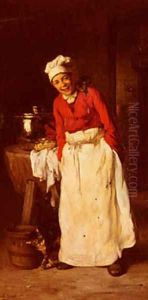Bail Joseph Paintings
Joseph Bail, born in Limonest, France, in 1862, was a distinguished French painter known for his intricate domestic and genre scenes that impeccably captured the essence of French bourgeois life in the late 19th and early 20th centuries. His artistry was deeply influenced by the Realist and Academic traditions, yet he infused his works with a lightness and humor that made them uniquely his own. Bail's father, Jean-Antoine Bail, was also an artist, providing an environment steeped in artistic tradition and fostering young Joseph's developing talents from an early age.
Bail's formal art education began at the École des Beaux-Arts in Paris, where he studied under influential artists such as Jean-Léon Gérôme, a leading figure in French academic painting. This education grounded Bail in the technical precision and compositional skills that would become hallmarks of his work. Throughout his career, Bail exhibited a keen interest in the everyday lives of his subjects, often depicting cooks, maids, and children engaged in mundane activities. Yet, he elevated these scenes to something more profound through his meticulous attention to detail, composition, and the interplay of light and shadow, imbuing them with a sense of dignity and timeless charm.
Joseph Bail's contribution to art was recognized during his lifetime with numerous awards and honors. He regularly exhibited at the Paris Salon, an annual art show in France that showcased the best of contemporary art, where he received critical acclaim. His works were sought after by collectors and art enthusiasts, not only in France but across Europe and in the United States, reflecting the universal appeal of his themes and technical mastery.
Despite his success, Bail remained dedicated to his craft, continuously refining his techniques and exploring new themes within his chosen genre. He was not just a painter but also a teacher, passing on his knowledge and passion for art to the next generation. Joseph Bail's legacy is that of a painter who captured the beauty and dignity of everyday life, making the ordinary extraordinary through his artistic vision. He died in Paris in 1921, leaving behind a body of work that continues to be celebrated for its contribution to French art and its depiction of the human condition.

